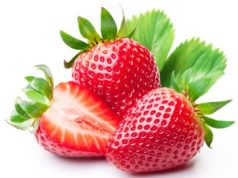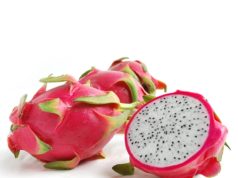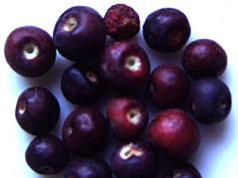Wild pomegranate is one of those fruits which have got great economic importance in their respective regions. It grows in the vast tract of the hill slopes of J&K, Uttaranchal & H.P. Its seeds are sun dried to make anardana.
Every year, anardana worth thousands of rupees is collected from the hills and sold at various places throughout the country.
Besides anardana, a huge quantity of the fruit rind, worth thousands of rupees, is exported for use in various industries.
Morphology
An erect deciduous spreading shrub or tree, 8 to 10 m high; stem, woody and thorny; girth of main stem, 48 to 78 cm; wood very hard and light yellow; leaves shed in December, new light red leaves appearing in the middle of March. Leaves, opposite, lanceolate, shinning from above 5.5 cm long, 1.6 cm broad, having entire margin; petiole thin, 3.8cm long; leaves often clustered on arrested branchlets.
Flowers, sessile, ebracteate, complete, actinomorphic, persistent, thick, fleshy, 2.9 cm in diameter; petals, 6; stamens, numerous; ovary inferior. Seeds angular with a fleshy aril which constitutes the edible part; colour varying from red to pinkish white.
Uses
It is mainly used in preparation of anardana, which is used in making chutney and as a souring agent in various preparations. The price of anardana in Jammu market which is an important centre for this product is up to Rs. 120.00 per kg.
The dried rind yields a fast yellow dye, which is used for dying cloth and making hair dye. Dastur (1964) reported that root bark contained 22 per cent of tannins which could be used for tanning and dying leather. Kasachava et al. (1973) stated that the fruit rind contains 30 per cent tannins for tanning leather.
The juice of the fresh leaves and young fruits is useful in dysentery, whereas bark contains an alkaloid and punicine, which are highly toxic to tapeworms. The unripe fruits and flower buds are astringent, and are useful in inducing vomiting and the rind of the fruit is given in chronic diarrhoea and dysentery.
The juice of the fruit can make a good squash. The wood of the tree is very hard and durable. It is generally used in making agricultural implements.
Chemical composition of the fruit
The edible portion, which is 62 per cent of the whole fruit, contains 69.5 per cent moisture and 58 per cent extractable juice. The total soluble solids content of the juice is 15.8. The acidity and pectin content of fruit is 5.46 and 0.05 per cent, respectively.
The edible portion contains 9.92 per cent total sugars, 7.52 per cent reducing sugars 1.01 per cent non-reducing sugars. The proportion of Vitamin C is 32.86 mg per 100 ml of juice. The tannin content of edible part is 12.67 per cent, while that of rind is 8.25 per cent. The protein content of the edible part is 2.03 per cent.
Flowering and fruiting season
The flowering season of the wild pomegranate in J&K was observed to be from March to last week of May. However, the fruiting season under these conditions was observed to be from last week of August to end of September.
Yield
The yield varies with the size of the tree. The average yield recorded during 2005-06 under Udhampur conditions was 29.8 kg per tree.
[indeed-social-locker sm_list=’fb,tw,go1′ sm_template=’ism_template_1′ sm_list_align=’horizontal’ sm_display_counts=’false’ sm_display_full_name=’true’ locker_template=2 sm_d_text='<h2>This premium content is locked</h2><p>Share This Page To Unlock The Content!</p>’ ism_overlock=’default’ ]
Significant Research Achievements
So far, the seeds of wild pomegranate, which are fleshy, are just spread on the roofs and sun-dried to make anardana. The growers are not awared about the hygienic production of anardana.
Even on roofs of houses, cowdung is pasted and the seeds of newly harvested fruits are spread on it after separating from septa and rind.
However, some agrotechniques have been refined out for qualitative and quantitative production of anardana under HTMM-I project. The care must be given to the plants regarding their nutrition as well as their timely pruning for increasing the quantity of production.
The growers used gunny bags for drying of seeds which resulted in the quality deterioration of product thus instead of these gunny bags, muslin cloth has been used which is proved to be helpful in maintaining the quality of anardana.
Also, separation of seed from rind is a cumbersome process as it resulted in the staining of hands as well as clothes. By using surgical gloves for separation of seeds, this can be controlled.
The growers mainly dry their product in open sun rays which resulted in mixing of foreign particles as well as dried leaves of other plants which reduces its market price.
Thus, a polytent house structure is being used for sun drying of anardana. The quality of product is similar to that of dried in open sun light. Hence, by using these methods, the quality of the anardana can be improved which will give good price to the growers in the national market.
[/indeed-social-locker]








